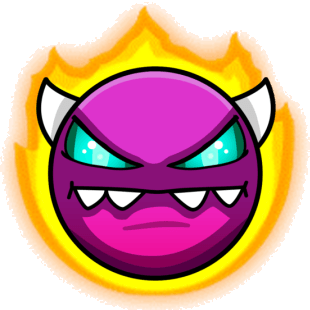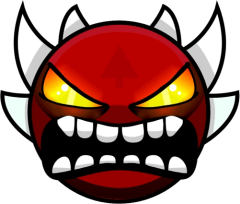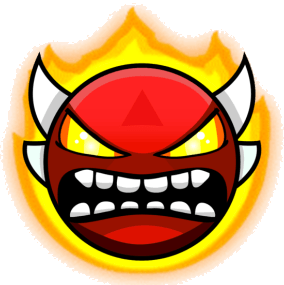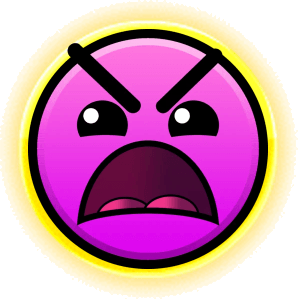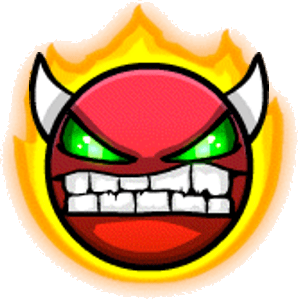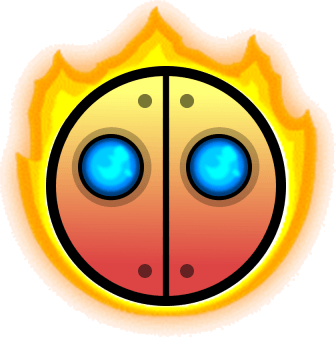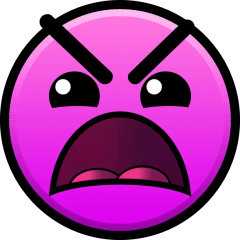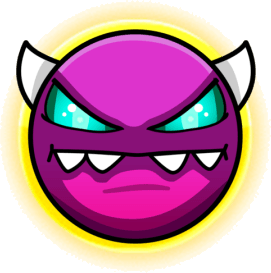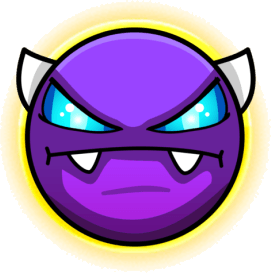Junior Member · he/they · Austin, TX
Rating Curve
Filters
Reviews
I know this is a very cold take, but I really do feel WELL RESTED is one of the best levels ever made, and one I just could not find any flaws in.
You know how some songs have an awkward introduction? The song would do some weird out-of-place notes before dunking into the actual song, and I love when songs do this. However, it's really hard to replicate the sensation these musical moments bring into GD levels since you also need to accompany it with visuals and gameplay. WELL RESTED pulls this off exceptionally well, and with a song with a longer awkward intro too. I would say the first 25 seconds of the level is one of my favorite parts. It feels like WELL RESTED is still booting up, as the level and the song wind up into existence together. The song only has funky drums and distorted voice samples, and the part of the level has simple but funky gameplay, a loading screen-like background, and structures and colors that move and pop in beat with the song. After one blue orb, you fall a bit more than anticipated...
...you hit the ground, there's a flash of light, and you are in a new scene. It looks and feels heavenly. You're in this otherworldly garden, on this big pearly white marble structure over some gorgeous waters looking out towards a magnificent blue abyss. The flora has this great shine to it and is adorned with beautiful patterns. After the dark and somewhat muted introduction, this change of scene hit me like a truck. Neither of these two parts are my favorite primarily because of what they are individually, but because of how one leads into another AND this is the first thing WELL RESTED hits you with. The song starts with one really long synth chord with a few occasional notes in beat with player inputs. There is one sequence where the player does three inputs back-to-back. Each time, the player rises up a bit more than normal thanks to some levitating pads. WELL RESTED utilizes these all throughout the level. Not only do these airborne pads make the gameplay more varied, it also helps the player's movements visually synchronize with the song as well, and these both make the utilization of these pads feel satisfying every time.
The song and the level start to speed up. Some bass and vocals kick in, and the player is doing inputs more often. Then, the song shifts into its normal groove and 2x speed. Most parts of the level from here on out work because of similar reasons to each other, though each part still looks unique from its surrounding sections. All of the colors work great with each other. All of the structures work with simple patterns and designs that never feel lacking because of what each of these level elements are paired with. It's all a great blend of heavenly and futuristic. The floral decor this level has strikes a great balance between natural and artificial while having a sleek, modernistic look. The level spends most of its time with a really well-made gradient background (really impressive for being done in 2.1 before the advent of the gradient trigger) that is just as pleasing to look at as the vivid gradient of a clear blue sky and some rising particles that resemble stars. It's a very simple background, but it's invigorating in the same way as the actual sky it is trying to emulate. Another thing WELL RESTED does that keeps the level feeling lively and eventful, aside from its visuals, is the fact that the camera is almost always moving. With the exception of certain sections, the usage of bordered gamemodes in WELL RESTED is very short compared to that of the unbordered gamemodes. Bordered gamemodes hold the camera in place for too long for WELL RESTED. You're always going up and down and fast and slow and this way of making gameplay gives the level so much more energy than it would have otherwise.
After a space-like segment, you fall once again, but this time the level cuts to black and fades back in. The level is really slow now, the structures are dark with rainbow outlines, there is a purple twilight sky with some drifting stars. Non-English runes are printed on the sky as the lyrics of the song are read at the top of the screen. This part already gives goosebumps because it's a moment for you to brace yourself for what comes next. All the level elements fall away, some art displays on screen, and then it happens.
Okay, before I talk about that one part of the level, I need to address the elephant in the room first. There are these black borders on both sides of the screen for everything up until this point. It's one of those things where upon booting up the level, the player notices them, thinks it's an odd choice, and then immediately adapts as they focus on trying to play the level. It does make the level up until this point seem a bit more cinematic having it at 4:3, but it's what the level decides to do with these borders that make their usage truly special.
The borders disappear off-screen, there is a flash of light, and the level and song reach their climaxes. The sky is full of shooting stars. The dark structures and the rainbows stand out firmly and beautifully. You aren't just in space now, you are dashing among the stars. They twinkle and shine on your command. You are a god now. You are WELL RESTED for the ascension. All the while the song is going through a divine synth passage and the pre-chorus repeats, but even louder with more energy. This is one of my favorite parts in any GD level ever. It would still be one of my favorites if it were standalone, but it is this buildup and release that is truly unlike anything I've ever felt in my 11 years of playing GD. After this level, the level comfortably works itself down from this insane soaring high with the intro reappearing in a glitchy, distorted way as you're being spoken to in this smooth, yet also glitchy and distorted spoken word passage.
The level continues to work itself down smoothly with more heavenly futuristic garden landscapes like what we saw before the climax. The borders start closing back in and the level returns to 4:3. The level eventually restabilizes on a scene very similar to what we first saw, with pearly white architecture, perfectly lush greenery, the water flowing, and the sky's blue abyss. More and more elements of the song start dropping out, and the gameplay corresponds by getting simpler and less involved. The level reaches a final elevation, inputs are very spaced out, Sarah Bonito gives us one final spoken word passage, and the credits appear accordingly with the final remaining beats of the song. Once the final beat passes, the credits fade away. This is what the end looks like: a garden with the greenest grasses and bushes, a fountain with the clearest water, architecture of the gods, and only the sounds of birds chirping and the water running. It's a very simple way to end the level consider the highs this level spends a lot of its time in, but after 7 minutes of action and some very high nerves, it's so deeply satisfying.
The one main point I have been hinting at throughout this entire review is this: The level and the song go hand-in-hand. In fact, they go hands-in-hands with both hands, that's how well WELL RESTED represents its song. No other level could use this song like how cometface did, and a level with this design, theme, and execution could never work with any other song. The gameplay (which admittedly I didn't talk a whole lot about in this review) is perfect, I have no complaints, there are no choke points or bugs, and it is always fun to play and extra satisfying since you move in tandem with the song. If you want to get more into playing XXL+ levels, WELL RESTED is a must-do. It's only medium demon as well, so you don't have to be too skilled to give it a shot.
(Disclaimer: I have not beaten this level, nor do I have plans to. Every End is a level that is way too far out of my skill range. While I will be talking about the gameplay of Every End, take everything I say about it with a grain of salt as I have only done two practice runs. I would omit having an overall ranking and just rank visuals, but I can't so I set them both to be equal.)
Of all of the megacollab hosts in Geometry Dash, MindCap is my favorite. Lately, the projects he has organized and released are all unique in some way and it seems like he organizes these level projects to give something of substance to the GD community and overall just make it a better place. Every End is no exception, and I would even say that it best exemplifies this aspect of MindCap's works the best. It's his most unique project yet, and one of the most unique top 10 demons we have had in a long time.
MindCap's goal with Every End is to have a top 10 extreme demon that is very accessible. You do not have to be proficient in the current top 10's meta of inhuman wave skill, spam control, and fixed hitboxes. Every End achieves its goal in a very simple way: throughout its entire runtime, Every End's gameplay consists of only the cube gamemode and 1.0 blocks and spikes. This brutal simplism kept up for 7 minutes straight creates an end product where you are able to do parts of the level in segments, but stringing it all together into one legitimate 0-100% run is a true test of endurance, nerve control, and understanding of the cube's physics and the game's hitboxes. Every End even does one more thing better: it alters its hitboxes to be even more fair and lenient. Almost every hitbox is normal in Every End, but on certain jumps that require you be on the very edge of platforms or other times when you get really close to spikes, the hitboxes are adjusted to make the jump not nearly as outrageously difficult as it would be otherwise. I was able to find moments like these everywhere in the level when doing practice runs with "show hitboxes on death" enabled in MHv8.
I also love the visual style of this level a lot. Every part is similar - they all use the same palette of objects, they're just constantly rearranged in unique ways, and the result is a lot of clever block designs and structuring that comes from these limitations. This level does something else to stay fresh throughout. The default background with the squares opens up to reveal layers behind it in the distance that have what would next in the level scrolling left and right through the layers until you've finally reached them. Something about it makes the level feel much more powerful, aside from just being atmospheric.
When playing and watching Every End, I was always thinking about The Impossible Game. Every End felt less like a level from the earliest 1.0 days of Geometry Dash, but rather a love letter to The Impossible Game. I played through TIG a few months ago. I didn't really like it. The physics was super inconsistent and clunky, my game crashed when trying to go for the 500 attempts achievement, and the TIG editor is so archaic and limiting you could've told me it was meant to be user-unfriendly and I would believe you. Yet despite these drawbacks, I was still very charmed by TIG. It was very simple with just blocks and spikes. The game is soundtracked with 2000's trance-techno EDM freshly sourced from Newgrounds. It had some unreasonably difficult levels with timings and blind jumps, yet it still welcomed the player with open arms to attempt the game's challenges. Every End acknowledges these similarities, the ground spikes in the final part of the level have been flipped upside down to appear as just a line of black glow, like the ground spikes in The Impossible Game. It's at this point the song and the level shift tone from its trance-techno sound into a solemn, organ-like synth passage as the level goes dark and the level's background closes up and seals itself. It almost feels like a memorial to something. The End of something. Every End of something. If we all still played The Impossible Game, what would the final level look like? The hardest level ever humanly conquered? It would perhaps look something like this. It's this something that truly elevates the level far beyond just being a 1.0-inspired or TIG-inspired marathon extreme demon. This is the level, these are the blocks, and these are the spikes at the human skill ceiling of The Impossible Game. In Every reality where we still played The Impossible Game, this is what the End would look like.
Or I'm just looking into this way too much. One or the other. These are my two cents anyways. Thank you to Omar Mind Cap for hosting this level.
My thesis for Future Funk was as follows: This level is the spiritual successor of High Life. To briefly summarize, I loved Future Funk because the level's infectious euphoria, how it progresses, and how firmly it embraces its inspirations and the point in time it was made in.
With that said, my Future Funk II thesis is as follows: This level feels like a sequel to Future Funk. My primary emotions surrounding Future Funk II were those of confusion and disappointment. This is the sequel to Future Funk? Yes, Future Funk II does do some things right. The backgrounds are really well-made and feel super naturally made despite being made before the addition of shaders. There are also some really creative and well-executed ideas, like the temple part with three floors and the double jump robot part. The problems with this level aren't that, it's that this level's entire premise, and what it leans on too much, is that it is the sequel to Future Funk.
It's hard to describe how exactly things went wrong. Was there something lost in communication? What did Jonathan think the most liked parts of Future Funk were? It feels like it was made by Jonathan in the sense that all of his building tropes and things unique to his levels are present in this level, but it doesn't feel like it was made by Jonathan since it feels like it misunderstands what made the original Future Funk work. This level feels like a watered down version of the concepts of Future Funk and they're diluted to the point where it feels like the inspirations that Future Funk wore proudly on its sleeves, Future Funk II actively tries to hide them. Instead of feeling like remakes of parts of High Life that never existed, they're remake parts of Future Funk that never existed. It doesn't hit the same. I don't feel as connected. Part of Future Funk's charm is that while it is still a very well-made level, especially for 2018, you can see that it is still rough around it's edges. It also has a very powerful progression (I went very in-detail in my Future Funk review about its progression). Future Funk II is way too well-polished and has a very weak progression by comparison. This is evident in the parts which directly reference parts of Future Funk.
For example, the cave part in Future Funk has rocky structuring and a mini cube that you need to learn when to time your jumps. It also helps start building up into the dual. Future Funk II references that part at 60% but it's just poorly executed. You transition into the part very poorly and it doesn't match the part of the song very well. It almost feels like a placeholder with how odd its placement in the level is. This is also a great example of being way too well-polished - the cave part in Future Funk's structuring is very crude around the edges and is a little hard to discern at times. It's all perfectly uniform in Future Funk II, and any semblance of a cave theme has been diluted to oblivion here. Not to mention there are jump indicators in this part so there is no challenge at all in playing it nor learning how to do the part, because you don't need to learn it (quick aside: Future Funk II has jump indicators everywhere while Future Funk is very sparing in its usage of jump indicators).
Another great example has to be the duals/the final stretch. Future Funk has its dual part from 62-70%, which gives the player some room to breathe between the dual and the finale and giving the level a stronger progression. Future Funk II has its duals from 82-89%, and they have no time to breathe before diving right into the final stretch. These are two major choke points back-to-back at the end of the level, and the player has no time to breathe or go through any other feelings during this part. It's just "gotta really focus" then "cool, gotta really focus again." The placement of the dual in the level is so poorly done, it almost feels like the inclusion of the dual was a tertiary idea as it just needed to be somewhere, and Jonathan happened to not build it anywhere earlier so he needed to insert it here before the finale. What made 99% in Future Funk so infamous and daunting was how the level starting winding down into its finishing blow at 96%. Future Funk II once again gives the player no time to breathe, and gives the player the 99% timing immediately after a choke point-ridden dual and finale. I should mention, 82-100% is full of inconsistent parts and awkward click patterns. While Future Funk is more overall with how it makes its difficulty, Future Funk II is a lot more focused on high CPS and funky click patterns. Future Funk II's duals also have jump indicators in places that make the learning the duals very easy and the dual is separated into 4 segments as opposed to being one continuous challenge, both of which make the dual less satisfying to have learned and consistent. All in all, the execution of the dual and the finale is botched on so many levels.
The last problem I have, which somehow doesn't sting as hard compared to my disappointment I laid out earlier, is that the gameplay just isn't very good. Future Funk II is somehow even more choke point-driven than its prequel. The second half of the first drop at 41% is ridiculously learny. At such a fast speed, I didn't have time to process all the gravity changes, I just brute forced the dual wave sequence until I had it memorized. The parts in the drop where you are teleporting frequently also has its gravity/size changes placed inside the teleportation portals instead of before/after them, and that's a location where I can't focus on them. Instead, I also just memorized what teleporters did what. Future Funk II also has the tendency to just throw the worst spam parts at you in awkward moments, like the H-block/red orb combos at 51% and the square orb-UFO transition sequence at 91%. I just did not have fun with these parts and most of my deaths were at dumb choke points like these.
TL;DR this level fails as a sequel, failing to reproduce the charm and what made the original Future Funk powerful to begin with, on top of just not being a fun level to play. I do not recommend this level.
When I play XXL+ levels, something I always look for and appreciate is if a level has a strong progression. For me, a level that feels like it goes nowhere and doesn't progress at all is one of the worst possible things an XXL+ level can do, and I feel like I wasted my time.
So when PAHC recommended me From Dust (his own level) last week and I saw the first part and realized the entire level was focusing around the level, I got excited to try it. A few days later, I beat the level after an unlucky 98% death. I didn't mind this death actually, as I got a chance to replay the level and look at the finer details again. New elements of the level are added at a sort of exponential rate, where it starts out really slowly but then gets overwhelming with how much is going on by the last minute. The way new elements are added is also really smooth, it is easy to overlook something new that is fading in until it is already fully visible. These two things also go hand-in-hand with its song, which I would normally consider difficult to use because it is all build-up and no release. Despite this, PAHC found a way to make great use of the song.
The most common criticism of From Dust is the gameplay, and while I don't entirely agree with its criticisms, I do see where some of them come from. The gameplay consists of the same sequence of ship gameplay that goes through iterations along the visual/song progression. I felt that the gameplay strikes a good balance between requiring a certain amount of focus while also not demanding too much, allowing me to take in the design of the level as well and try to look for newly added elements. I don't like how some of my deaths (including my 98% one) were caused by jerky movements of some blocks, which could launch me up/down into other blocks and kill me. The ending, where the level just cuts off with the song, caught me off guard pretty well the first time, but it never really hit the same after that. I feel like the level could've had a stronger ending, but at the same time it's hard to properly wrap up a level that uses a song that's only build-up and no release.
(This part is a bit of a rant) From Dust has also spurred some discourse surrounding how the level begins, where the level slowly eases into requiring any amount of inputs. Some consider this long, unskippable intro a waste of their time. Here is my two cents: I would also dislike this aspect of the level if the level itself was difficult, but it isn't. This took me 11 attempts total, and I learned the whole level in one practice run. It's rated 8 stars. Besides, just as a concept, really long GD levels themselves are a waste of your time, and if you are truly concerned with using your time the most optimally, From Dust isn't the level for that. From Dust is a level that focuses on build itself up gradually over time, and that's what I like about it so much.
For almost 5 years, I was wrong about this level.
When Future Funk released in 2018, I was 11 years old at the time. I loved the level immediately and knew I wanted to beat it someday. However, if you asked me why I liked it so much then, I probably would've struggled to explain.
Fast forward to some point in early 2020, I am 13 years old and I have approximately 2-4 hard demons under my belt, and I decide to finally go for it. Initially I was loving it, but then my feelings immediately went sour. I struggled with the level heavily, the most frustrating choke points for me included the Clutterfunk mini cube part from 25-29%, the first High Life part from 40-51%, the infamous asymmetrical from 62-70%, and the final stretch from 90-100%. I considered any attempt that reached the first High Life part a good run, and the dual in particular was the bane of my existence. Eventually, on June 28, 2020, I conquered Future Funk after 2 99% fails, and it was my new hardest as well as when I hit 5000 stars. It was a big moment for me, not just as an accomplishment for me as a player, but it also planted the seeds for the cynical outlook I have now regarding contemporary hits in GD. Future Funk was when I learned that just because a level looks amazing, it doesn't mean it plays well. In fact, sometimes the level can play quite poorly because more priority is put on the visuals over the gameplay. Future Funk was one of the most beautiful levels in the game, but at what cost? I never got to really see its beauty too much when grinding it because the level would lag on my laptop and I had to use LDM. This mindset I have now with a much stronger emphasis on gameplay and less focus on having the level that caters to the most people as possible has helped me understand my own tastes a lot more, but I had always regarded Future Funk as a 3/10 level ever since I beat it.
Fast forward again to March 14, 2025 (two weeks ago as of me writing this), I am 18 years old. I don't entirely remember what led up to me deciding to do another practice run, but I decided to replay Future Funk. This was the most odd I had ever felt replaying a level I played a lot years prior. Since 2021, I have had a much stronger gaming PC so I was able to run the level in full detail and see the level in all its beauty, and it all holds up really well exactly 7 years later. I also experienced something even stranger: I was having a lot of fun with this level. Maybe it's just that I am far more skilled player now than I was in 2020, but I really enjoyed my practice run and every part of the level felt good to play. I even somehow managed to retain my dual muscle memory (while this may have a played a part in me enjoying the level more, I am better equipped for learning asymmetrical duals now and I doubt I would have taken long to learn it if I had to do it from scratch). I decided that I will rebeat the level now just to make sure I wasn't losing my marbles during that practice run, and I'll even collect the first coin this time to assert dominance over 2020 me who didn't collect any of the coins. Yesterday, I rebeat it after a lucky fluke from 69% (but with 5 dual deaths) to confirm that I was not, in fact, losing my marbles. That's when I knew for certain I had spent the past almost 5 years being wrong about how I felt about the level.
The simplest way I can put how this level feels is this: this level is the spiritual successor to High Life. Yes, High Life is a primary inspiration for Future Funk alongside Clutterfunk, both of which are inspirations that Future Funk wears proudly on its sleeves, but that's not exactly what I mean. High Life has a very specific charm to it being a relic of its time (1.9-2.0 fusion cuisine from 2015) which makes the level's euphoria all the more powerful. Future Funk is the exact same way, but with update 2.1 in 2018. Both levels are so infectiously euphoric and powerful that viewing only them and the context of them being from their specific points in time would be looking at those eras of the game through rose-tinted glasses. Not only were 2015 and 2018 times when the GD community was very toxic, very few levels felt as powerful and happy as Future Funk and High Life, and most levels from 2018 certainly don't hold up as well as Future Funk.
While at a glance it may seem like Clutterfunk and High Life has equal amounts of influence in Future Funk alongside original parts (which are able to stand on their own two legs), the High Life inspiration is a lot more felt throughout this entire level than the Clutterfunk inspiration. Clutterfunk is a lot more of a foundation as it is automatically iconic being the 11th main level, and the main level best tailored to something like Future Funk, being the funkiest main level. When the High Life-inspired parts first start appearing at 40%, Future Funk is able to make its own creative parts off of the designs and sections of High Life in a way that is to perfectly recapture the original level's euphoria while in a completely new context and song. There are parts in the second half that are completely original, but because of how well they are made alongside the High Life-inspired parts, as well as how the completely original stuff and High Life inspiration is mixed in, they legitimately feel like revamps of parts of High Life that never existed. Future Funk would feel incomplete if it relied entirely on being a Clutterfunk remake, but it would not feel nearly as incomplete if it was entirely a High Life remake.
I don't have as much to talk about on the gameplay as I do the visuals and the elements surrounding Future Funk but I'll touch up on it briefly. It's amazing. Yes, there are choke points, like the ones I outlined earlier when talking about me playing the level in 2020, but revisiting the level has made me feel these choke points aren't as bad as I thought. The level's progression is stellar as it is more relaxed for the first half, existing mostly at normal speed or 2x speed, but as the level winds down then up into the dual, the nerves start to kick in. After the dual, the level slows down again, but you need to maintain your nerves. The level then works back up into a final high, which the song pairs with the last 10%. It settles on that high for a bit but then winds back down at 96% as every element of the song goes away leaving only the percussion as you repeat the same easy jump. Then you're hit with the 99% orbs, which has to be the most infamous 99% part in any level, and what influenced a lot more 99% choke points to come. You will die here if you can't control your nerves or if you just don't know the timings. Even if you do know how to do 99% well, it's still looming over your head the whole time you are playing the level. Everything I just mentioned works so well. Near the end there are more parts which do not take inspiration from Clutterfunk nor High Life, but they are able to properly stand on their own and be memorable because of how the level progresses and builds up. It's one of the best level endings in GD.
Despite my newly found appreciation for all aspects of this level, I would still not recommend it to players as one of their first hard demons. While it may be longer with its raw difficulty almost never being exactly at hard demon, it still has choke points which can mess up players like 13-year-old me who didn't know how to prepare for them. Otherwise, I would recommend giving this level a shot or a revisit since it's still a good challenge and just a fantastic level all-around.
I usually don't review auto levels or levels this short, but I want to write write about why this is my favorite auto level in the game.
CUBETAPPER is a recreation of the music video for Frums - WAVETAPPER, which features 15 minecraft-like cubes of different colors which light up and display symbols in correlation with an instrument of the song (we don't talk about the gray cube). They all come in at different times and take breaks as they need to to work with the song. It's already a really creative music video, but Epsilon finds ways to improve it in his recreation and also add his own creative value.
One problem that the WAVETAPPER music video suffers from is that it feels a bit too still and lifeless. Visually, it is as simple as it can get to a point where it holds the music video back. CUBETAPPER fixes this problem with some subtle camera shaking and lens circle usage throughout, as well as making the off-white background darker at the bridge. WAVETAPPER also has zero movement going on, all of the color changes and visuals are confined to their respective, stationary cubes. CUBETAPPER's approach of using GD cubes is implemented really well. Most of the cubes physically move then they play their respective noises. The default cube hits its own sides with its core for the percussion, the icons that resemble faces move like they are singing their vocal samples, it all feels natural. Some cubes which are not playing at the moment will go off screen and recruit more cubes, filling up the screen as the level progresses and making the song's progression easier to visualize. Other cubes that are not playing are still animated and moving as though they are actually alive. Some look around, blink, and the 1000 star cube even stretches in place. They're also all just some of the best cube recreations I've seen in a GD level, they're almost 1:1. All these factors combined make CUBETAPPER interesting to watch the whole time and never boring.
One of my favorite details, which I did not notice until watching WAVETAPPER and CUBETAPPER back-to-back, is that the glitch-like effects that appear around the cubes in CUBETAPPER at the final chorus are all recreations of the symbols that appear on their respective cubes in WAVETAPPER at the same point in the song. Not only is it is a really neat reference, it's also just a sick effect as well. I also love how the replication of the phone dialing in WAVETAPPER is recreated perfectly as well, down to what numbers are pressed at what time and what the numbers translate to in text (which displays onscreen at the final part). It's clear a lot of effort went into this and that Epsilon has a lot of respect for the original music video.
All in all, I'm glad this level got as far as it did, even to the 2024 GD Awards nomination. It just does so many things right and is a truly well-crafted recreation of something outside of GD.
This will be a mini-review. This level currently sits at a heartbreaking 100 downloads, and I want to write about this level to spread some word about it.
Lasaga has been a creator that has been on my radar for a few years now. He was a very prolific and talented creator on the 1.9 GDPS and Burning Blue is his send-off level. I had always enjoyed playing his levels and how they were designed, as well as how he incorporated vaporwave and synthwave aesthetics into his creations. So when I found out he had made a 7 minute long 1.9 level with a synthwave song and design, I was pumped.
Burning Blue really does not disappoint! It is predominantly blue and orange with other neon colors mixed in at times, which combined with the song, gives the level a calming, sunset beach feel that is constant throughout even as the level tries out all sorts of block designs and air decorations. The level does not feel 7 minutes long, as I just get lost in the level's atmosphere while playing. It mostly sits below demon difficulty throughout and doesn't demand very intense concentration to enjoy. There are some parts where focusing is recommended, like the gray part at 68% where it can be difficult to see what the orbs are the quick asymmetrical dual bursts at 77%. The level is paced really well, changing speeds just enough to feel steady and match with the song without becoming stale. Burning Blue spends almost all of its time moving between half speed, normal speed, and 2x speed, so when the first and only 3x speed part at 89-94% with the highest point in the song then returning back to half speed for the rest of the level as the song wraps up, it makes for a truly satisfying and memorable ending.
Despite currently not being rated, I would still recommend giving this level a shot! For the most part, the level is well-balanced and sightreadable. I would personally place its difficulty at being an entry-level easy demon. It's just a really pleasant experience all around and it's a real shame this level didn't get the attention it deserved.
Before I start this review I need to give some background: I lost my grandmother to dementia in October 2022. It is brutal to watch someone who you have known and loved for so long become unable to walk, confused at her surroundings, and forget who you are other than "the little one." Dementia is a very personal topic to me and I take it very seriously. If you think you are ever trying to be funny when you depict dementia in any way, I will wipe your ass with sandpaper until it is dust.
With that said, my main takeaway from SAVE AS is as follows: good intentions and a willingness to treat its subject matter with the respect and sincerity it should, but stumbles on the execution.
SAVE AS tells its story in a similar way to The Caretaker's 'Everywhere at the End of Time' (one of my top 5 favorite albums of all time), where you sink into the void of dementia over time. A lot of details are never explicitly explained, allowing you, the player/listener, to come to your own interpretations on what a certain aspect means. I love this kind of stuff when it comes to art relating to neurodegenerative diseases, and I am glad SAVE AS honored that.
The visuals are amazing and help tell the story better than any words can. The level starts with this somewhat standard rainbow-grayscale modern style, which starts to fall apart and glitch out. The glitchiness is really well done and makes the level feel unstable and deteriorating in a very natural way. The block designs progressively degrading into being an absolute mess is also really well executed. You slow down into speeds far slower than the slowest speed GD speed portals have to offer, and by the end just moving one more block forward feels like it physically hurts to do. Overall, the level nails its goal of the level slowly forgetting everything it was and what it means to be a level, but at what cost?
SAVE AS is a Geometry Dash level, and not a YouTube video or a music album. It has gameplay and is meant to be played. It's also supposedly a pretty tough level, assessed at medium demon difficulty. The gameplay? It's not good... at all... the gameplay becomes just as unstable and buggy as the design of the level, but in a way that is detrimental to the playing experience. I want to appreciate this level so much more, but this holds me back a lot from doing so. If the gameplay remained bug-free throughout the level, I'd say this is a low-end easy demon, mostly because of the level's length. When the level repeats itself and moves the gameplay you just did back in front you, there are a bunch of unique ways you can die every time, most of which are unintentional. You start to lose control of your player as the level progresses, with the player getting thrown around violently with the level. It's a cool effect, but it really sucks when this results in your wave getting placed inside a block design and dying automatically or when a block moves to a spot which bounces your ship far up/down, also sending you diving into a wall and dying. More of my time spent trying to beat the level was learning how to get around these deaths that should not be happening, while the rest of time was spent feeling bored because the level is really easy for the most part.
I'm also not big on the song that was made for this level. A few years ago, I was super obsessed with The Caretaker's work as well as a frequent member in the scene surrounding fan-made works of The Caretaker, and the song just isn't a good depiction of dementia. The way the song distorts, reverberates, and repeats upon itself does not feel natural or realistic, as well as the original melody the song makes to later destroy is just lacking in general. While tripplebarrel did eventually take it down and make a new THE NOISE EXPERIMENT that's a bit better, it wasn't THE NOISE EXPERIMENT that SAVE AS was built around. PAHC plays the hand he is dealt rather well, but I still feel the song is a disappointing and lacking depiction of dementia.
This level does a lot right in trying to depict dementia, but I'd still say it is "getting there" as opposed to perfect. Despite that, I'm still glad a level like SAVE AS exists and that PAHC was the one to make it, since it is clear he gave the subject matter the respect and intent it deserved. SAVE AS was also just an influential level in general. Almost no one was making artistic statements like these in their GD levels in 2020, but PAHC helped push for more of them to exist, which is almost a greater accomplishment than what SAVE AS set out to do in depicting dementia.
This will be shorter review, as I don't have as much thoughts on this as I do some other levels I've reviewed. I'll also be comparing TLWH to True Values of Life (TVOL) a lot in this review as it's got a lot of similarities to that level.
I felt like this level suffers a lot of the same drawbacks as TVOL, albeit to a lesser extent. The biggest drawback to this level that it lacks any real progression and feels aimless at times, which is mainly caused by its song, Night Walk by Horsed, another ambient electronic track more meant to be listened to in the background of something else instead of being a central focus. Unlike Snowy Roads, the song of TVOL (also made by Horsed), there is at least a bit more going on in general throughout Night Walk and it is easier to build gameplay around.
TLWH can be repetitive at times with its designs and its gameplay, however it introduces enough things to keep the level somewhat fresh throughout, which cannot be said for TVOL. The design and gameplay of TLWH is also generally at just a higher caliber at all times than it ever is in TVOL (not saying a whole lot, this is a low bar to clear). TLWH is like TVOL where it fails in the song representation department, although not as brutally. There are a lot more things in TLWH that correspond with an element of Night Walk, and the backgrounds of TLWH generally have more muted color palettes to match with the bassy drones heard throughout Night Walk.
However, TLWH feels stretched for length at times, though not nearly as excruciatingly as TVOL. TLWH doesn't end at any major point in its song, it sorta just ends as its song continues for 5 more minutes. This is because TLWH ends really close to where the editor ends in GD. The level could go on longer if Renn decided to mod the game to make the editor even longer, but he doesn't because he doesn't need to. TLWH feels kinda unnecessarily long, but not as ludicrously as TVOL does. It's already long enough to be the longest rated level in GD, but not so absurdly long all of its flaws triple upon themselves.
If you are wanting to dip your toes more into beating the longest rated levels GD has to offer, I would recommend this level, but I don't feel that it is a must-do. It is so consistently easy throughout its runtime that I would go as far as to call it an entry-level easy demon. If you have hard demon+ skill level, I even bet you can even sightread this level.
TL;DR suffers a lot of similar problems as TVOL but to a lesser extent, still feels boring and stretched for length.
(Disclaimer: I have not beaten this level yet, though I plan to. I have only done 2 practice runs, but I feel I have played this level more than enough to write a review.)
This is one of the worst levels ever released. I'm hesitant to just call levels a "waste of time," especially because someone can always view a level in a different, more positive light than I could, however I just do not see the possibility for that in TVOL at all. I have yet to speak with anyone who likes this level, much less anyone who has beaten it who has liked the level enough to consider it a worthwhile investment. In both my two practice runs, I have felt excruciating levels of boredom.
Before TVOL even places its first block, it already shoots itself in the foot with its song choice. Snowy Roads by Horsed is not a bad song - in fact, I like it - it's just not a useable song in the context of a GD level. It is 48 minutes long, calm, peaceful, and does not progress at all, almost like an ambient piece. It strikes me as more of a song meant to be listened to in the background while doing something else as opposed to trying to build a level around it, much less using its entire runtime of 48 fucking minutes. If you would struggle to make an enticing level with this song that is only 1 minute long, how on Earth would you think making one that is 48 minutes long would have any possibility of being good? This makes me inclined to think Snowy Roads was chosen not because it is a good song, but rather because it is long enough to build a level of absurd length. This is also supported by the how TVOL just completely fails with song representation, as there is not a single part that syncs with the song or matches how it feels in any way.
This ties into my next gripe - I am failing to establish a proper justification for why this level was made. I do not like to have debates on why a level gets made in the first place, it is a redundant debate for a lot of levels, and can be answered with something as simple as "I built it for fun." I can't see how hosting a megacollab and building a level this monotonous can be any fun to do. This level did strike me as somewhat pretentious with how the levels takes itself seriously, calling itself "the 48 min collab" and "the longest GD level" on the end screen as well as directly challenging a bunch of famous people to beat, including RobTop and Viprin for some reason? Some names make sense, like Guitar and Dorami (who ended up verifying it lol), but others don't and this reads to me as a cheap way of getting a bunch of famous, powerful players' attention. If your level is good, you should automatically have their attention and you shouldn't need to add something like this. These things really rub me the wrong way and make me doubt if this level was built to have a nice product, or to have the fame to come from working on a level of such huge ambitions, and if it is the latter, thank god this level never got rated.
I'm diving into the sustenance of this level quite late into the review as there just isn't a whole lot of meat or much things of interest throughout this level. It feels like a 6* collab from 2017 stretched to 48 minutes in length (yes, this level released in 2019, this is how far behind its time TVOL is). This level starts to feel like the same slog even when you're only 25% though, because it kinda is the same at some parts. There are 47 builders (I may have counted wrong), and none of the parts are a minute long, therefore there are repeat builders multiple times throughout the level. Despite some builders having multiple opportunities, not a single part of TVOL looks good now, and a lot of them didn't even look good in 2019. They are riddled with visual errors: bad layering, awful color combinations, block designs that make it difficult to make out the hitboxes, objects with glow enabled that shouldn't, glow deco overusage, and really empty and bland parts (both glow style and modern style). The gameplay also suffers a lot of flaws: invisible gameplay, buggy parts, inverted slopes, parts where it is hard to tell the hitboxes of gameplay because of the decoration, parts where it is hard to tell whether something kills you or not, all indicators that this level did not get anywhere near enough playtesting for its size. The worst problem with this level, worse than any of the gameplay flaws I listed out, is that this level is just boring to play for its entire runtime, which is the absolute worst thing a level of this length can end up as.
I really hope I never have to write a review this negative ever again. However, I just had to go all out on this level because I feel like this level is genuinely unsalvageable and flawed all the way down to its very core. I cannot see a reality where any amount of tweaking and QoL updates to this level can make it anywhere near bearable enough to learn and beat in its entirety. This level truly should have just been scrapped in favor of something that could've had an opportunity to turn out better, I'm sorry.
GDPR Cookie Consent
Hyperbolus uses cookies and local browser storage to enable basic functionality of the site. If we make any changes to these options we will ask for your consent again.
sorry about this gang
